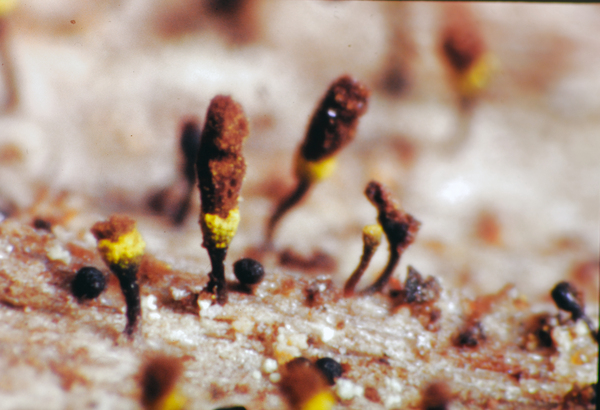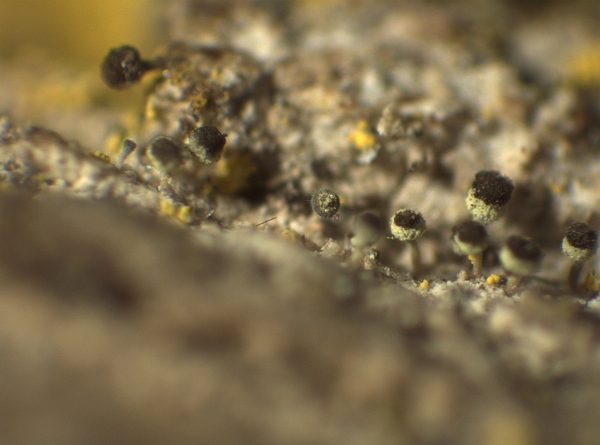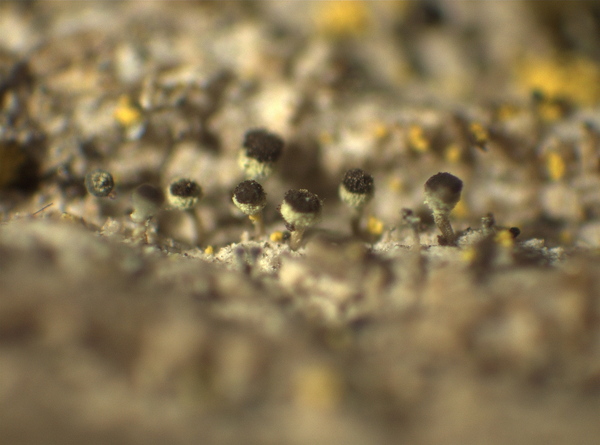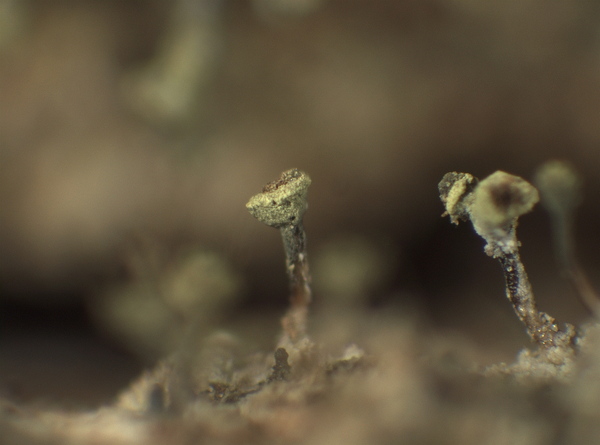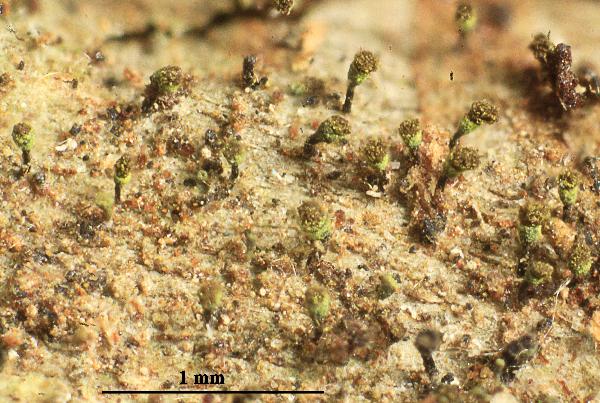Chaenotheca hispidula (Ach.) Zahlbr.
Cat. Lich. Univ., 1: 567, 1922. Basionym: Calicium trachelinum var. hispidulum Ach. - Lichenogr. Univ.: 237, 1810.
Synonyms: Calicium aciculare (Gray) Fr.; Chaenotheca acicularis (Gray) Zwackh; Cyphelium aciculare (Gray) Arnold; Cyphelium chlorelloides Anzi; Phacotium aciculare (Gray) Trevis.
Distribution: N - Ven (Puntillo & Puntillo 2009), TAA (Nascimbene & al. 2009, 2010, 2022, Nimis & al. 2015), Lomb (Puntillo & Puntillo 2009), Piem (Puntillo & Puntillo 2009), Emil (Puntillo & Puntillo 2009). C - Tosc (Puntillo & Puntillo 2009), Marc (Nimis & Tretiach 1999, Puntillo & Puntillo 2009), Laz (Ravera & al. 1999, 2000, Munzi & al. 2004, 2007, Puntillo & Puntillo 2009), Abr (Ravera & al. 2017), Sar (Zedda 2002, Puntillo & Puntillo 2009). S - Camp (CLU 17153), Pugl (Nimis & Tretiach 1999), Bas (Ravera & al. 2015d), Cal (Puntillo 1994, 1995, 1996, Puntillo & Puntillo 2004, Puntillo & Puntillo 2009), Si (Caniglia & Grillo 2006b, Puntillo & Puntillo 2009).
Description: Thallus crustose, endosubstratic, poorly evident. Apothecia short-stalked, pin-like, 0.5-1 mm high. Stalk 0.05-0.08 mm thick, black in lower part, bright yellow-pruinose in upper part, of periclinally arranged, medium brown hyphae. Capitulum to 0.3 mm across, obconical to obovoid, yellow-pruinose in lower part, the mzaedium well-developed, brown. Exciple well-developed, of periclinally arranged, medium brown hyphae; hypothecium medium brown, obconical, with a flat upper surface. Asci cylindrical, either estipitate and produced in chains or with a distinct stipe and formed singly, dissolving early, with 1- to 2-seriately arranged ascospores. Ascospores 1-celled, brown, globose, 5-8 µm wide, the wall with irregular, reticulate fissures delimiting polygonal areas. Photobiont trentepohlioid. Spot tests: thallus K-, C-, KC-, P-. Chemistry: thallus without lichen substances; yellow pruina consisting of vulpinic acid. Note: a cool-temperate, probably holarctic lichen found in dry hollows and undersides, and on the bases of ancient trees, especially oaks, in humid deciduous forests. Widespread throughout Italy, but not common. It is included in the Italian red list of epiphytic lichens as “Near-threatened” (Nascimbene & al. 2013c).
Growth form: Crustose
Substrata: bark and lignum
Photobiont: Trentepohlia
Reproductive strategy: mainly sexual
In underhangs rarely wetted by rain
Commonnes-rarity: (info)
Alpine belt: absent
Subalpine belt: absent
Oromediterranean belt: absent
Montane belt: very rare
Submediterranean belt: extremely rare
Padanian area: absent
Humid submediterranean belt: very rare
Humid mediterranean belt: extremely rare
Dry mediterranean belt: absent

Predictive model
Herbarium samples
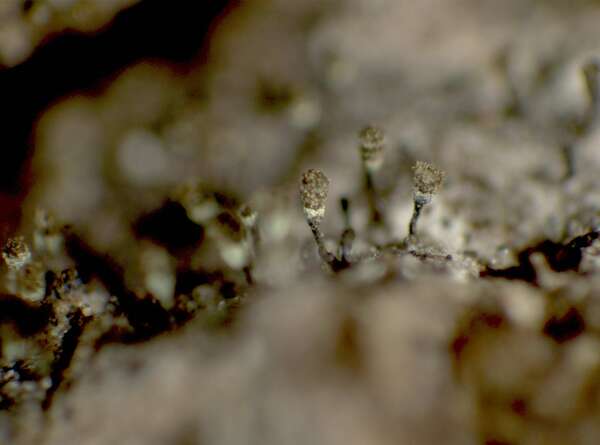

P.L. Nimis; Owner: Department of Life Sciences, University of Trieste
Herbarium: TSB (23482)
2001/12/05
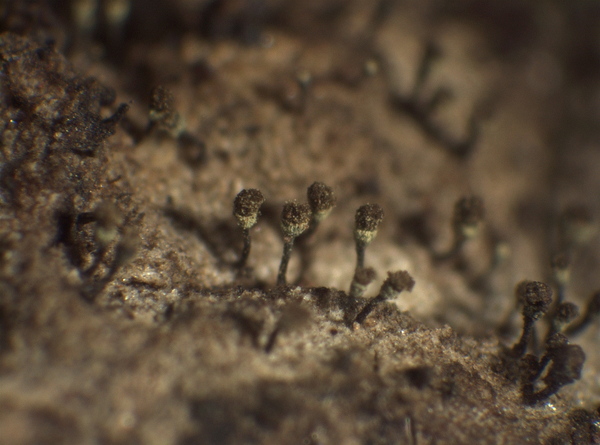

E. Pittao; Owner: Department of Life Sciences, University of Trieste
Herbarium: TSB (23482)
2008.03.10


E. Pittao; Owner: Department of Life Sciences, University of Trieste
Herbarium: TSB (23482)
2008.03.10
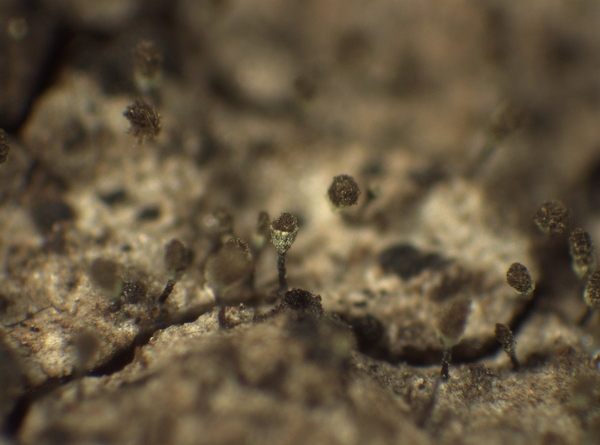

E. Pittao; Owner: Department of Life Sciences, University of Trieste
Herbarium: TSB (23482)
2008.03.10
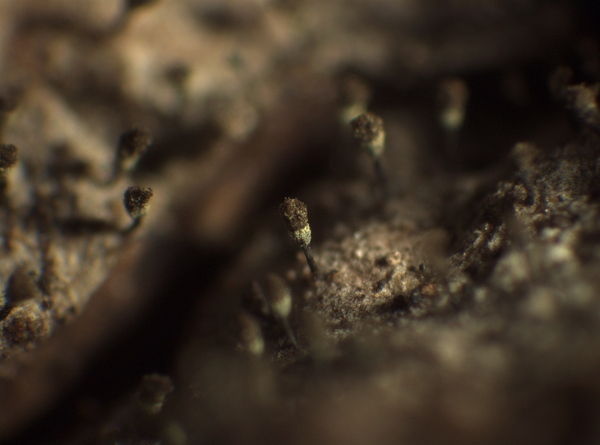

E. Pittao; Owner: Department of Life Sciences, University of Trieste
Herbarium: TSB (23482)
2008.03.10
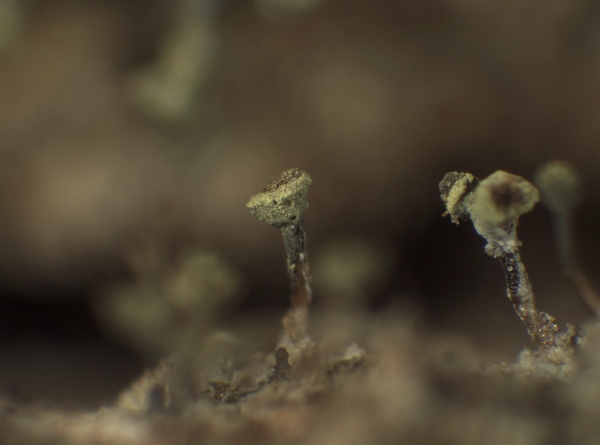

E. Pittao; Owner: Department of Life Sciences, University of Trieste
Herbarium: TSB (33501)
2008.03.10
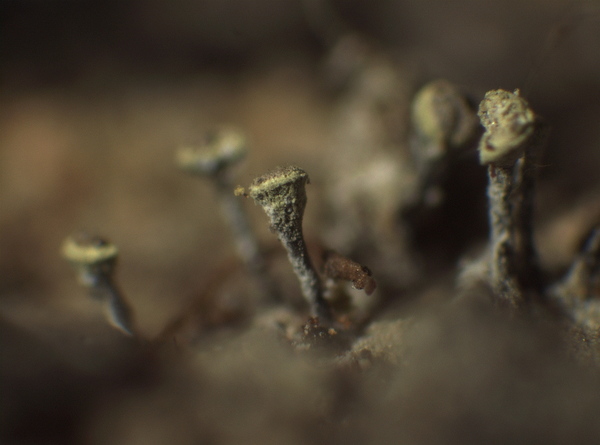

E. Pittao; Owner: Department of Life Sciences, University of Trieste
Herbarium: TSB (33501)
2008.03.10
Growth form: Crustose
Substrata: bark and lignum
Photobiont: Trentepohlia
Reproductive strategy: mainly sexual
In underhangs rarely wetted by rain
Commonnes-rarity: (info)
Alpine belt: absent
Subalpine belt: absent
Oromediterranean belt: absent
Montane belt: very rare
Submediterranean belt: extremely rare
Padanian area: absent
Humid submediterranean belt: very rare
Humid mediterranean belt: extremely rare
Dry mediterranean belt: absent

Predictive model
| Herbarium samples |


P.L. Nimis; Owner: Department of Life Sciences, University of Trieste
Herbarium: TSB (23482)
2001/12/05


E. Pittao; Owner: Department of Life Sciences, University of Trieste
Herbarium: TSB (23482)
2008.03.10


E. Pittao; Owner: Department of Life Sciences, University of Trieste
Herbarium: TSB (23482)
2008.03.10


E. Pittao; Owner: Department of Life Sciences, University of Trieste
Herbarium: TSB (23482)
2008.03.10


E. Pittao; Owner: Department of Life Sciences, University of Trieste
Herbarium: TSB (23482)
2008.03.10


E. Pittao; Owner: Department of Life Sciences, University of Trieste
Herbarium: TSB (33501)
2008.03.10


 Index Fungorum
Index Fungorum
 GBIF
GBIF
